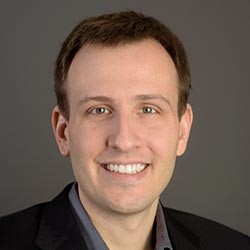“Teaching Old Active Sites New Tricks”
Wednesday, November 20, 2019
Perlstein Hall 131 – Auditorium
3:15 p.m.–4:00 p.m.
Abstract
Oxides are catalysts for many important chemical transformations, and they have been the subject of many decades of investigation. In some cases, significant aspects of their synthesis and of the operative catalytic mechanisms are quite well understood, while in other cases, there remain critical gaps in understanding.
Counterintuitively, this talk will focus on the former, well-understood oxide catalysts, or more specifically, on their active sites. This talk will argue that because fundamental aspects of their structure and function are generally agreed upon, they can be transplanted–in a rational way–into new materials or new reactive environments, which can lead to improved performance and new understanding.
Three vignettes will be discussed, covering three different length scales of new environments. These length scales begin with placing a known catalyst in a very atypical reaction medium in order to carry out tandem, orthogonal catalysis. Here that means finding a catalyst to use the H2O2 byproduct found in the effluent of a microbial electrochemical cell to carry out a selective oxidation reaction.
At the next scale down, we demonstrated that the strong Brønsted acid phosphotungstic acid (PTA) could be incorporated into the pores of the Zr-based metal organic framework (MOF) NU-1000. In doing so, we created the first MOF catalyst active for alkane skeletal isomerization, (e.g. xylene isomerization). Confinement of PTA within the MOF pores led to markedly different selectivity than that of a chemically similar WOx/ZrO2 catalyst, opening up many new avenues of investigation.
Finally, we developed methods to deposit controlled amounts of silica around and over the active sites of a conventional Ti-SiO2 selective oxidation catalyst. This allows construction of confined spaces only within 1 nm of an active site, which can help lower apparent activation energies for catalysis, without negatively impacting transport to the active site. This last vignette is an example of moving beyond identification of a catalytic phenomenon (e.g. confinement effects) to beginning to be able to control it rationally in designed materials.

Justin Notestein
Lead PI for the Institute for Catalysis in Energy
DOE center at Northwestern
Short Biography
Prof. Justin Notestein received his BSE at Princeton University in 2001 and his PhD at the University of California Berkeley in 2006, both in Chemical Engineering. Since 2007, he has been a member of the Center for Catalysis and Surface Science and the department of Chemical and Biological Engineering, where he now has the rank of Professor. He is the lead PI for the Institute for Catalysis in Energy Processes, a long-running DOE center at Northwestern. Research in Prof. Notestein’s group focuses on the development of new hybrid, oxide, and nanostructured catalysts and adsorbents for a number of transformations relevant to sustainable energy, selective oxidation, and improving industrial chemical processes. Special attention is on developing full synthesis-structure-function relationships for improving the process of new catalyst development.
